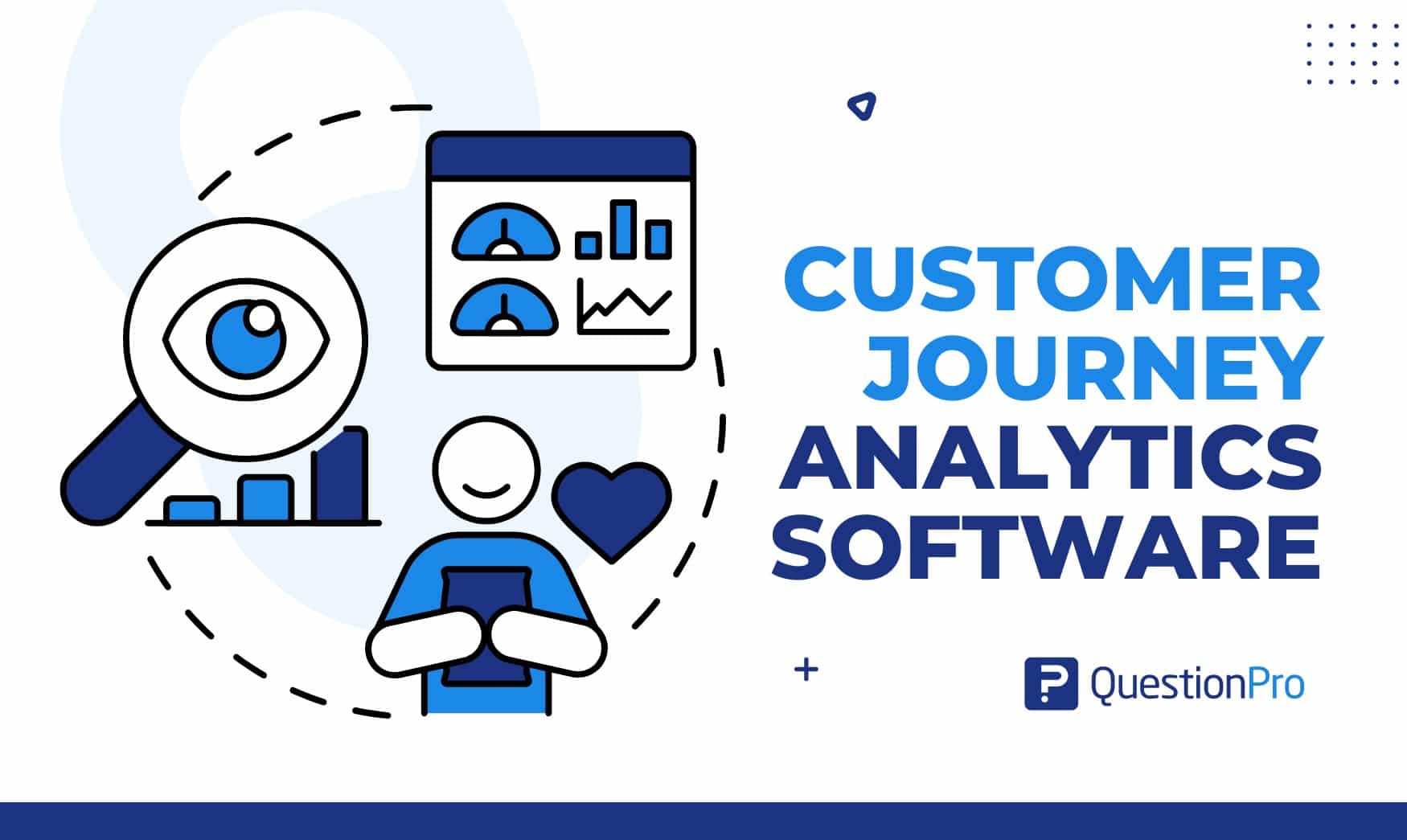
Customer journey analytics software is a crucial and adaptable tool that offers insights into customers’ paths. As we navigate through 2025, the demand for powerful analytics solutions has intensified, prompting the emergence of innovative software tailored to meet diverse business needs.
There are countless companies offering customer journey analytics software, each engineered to improve customer engagement. Businesses gain holistic insights into customer behavior that transcend individual touchpoints by aggregating data from various sources, such as websites, mobile apps, social media, and offline interactions.
Customer journey analytics software enables organizations to create customized experiences that deeply resonate with their target audience. Businesses can optimize marketing strategies, refine product offerings, and enhance overall customer satisfaction by identifying pain points, preferences, and moments of delight along the customer journey.
What is a Customer Journey Analytics Software?
Customer journey analytics software is a specialized tool designed to track, analyze, and visualize customers’ interactions and experiences with a brand across various multiple customer touchpoints throughout their buying journey. These touchpoints may include online platforms such as websites, apps, and social media and offline channels such as physical stores or customer service centers.
- Aggregates data from website traffic, social media, emails, and transactions.
- Provides a comprehensive view of the customer journey.
- Helps identify patterns, trends, and pain points.
Customer journey analytics software typically offers data visualization dashboards, predictive customer analytics, segmentation capabilities, and integration with other business systems to provide actionable insights that help businesses enhance customer satisfaction and loyalty and drive revenue growth.
Uses of Customer Journey Analytics Software
Customer journey analytics software serves many purposes for businesses, such as enhancing their understanding of customer behavior and improving overall performance. Here are several essential uses:
01. Identifying Pain Points
Analyzing customer journeys helps pinpoint pain points and areas where customers may encounter obstacles or dissatisfaction. This customer journey analysis insight enables businesses to address issues, improving customer satisfaction and loyalty promptly.
02. Personalizing Customer Experiences
Understanding the customer journey enables businesses to tailor experiences based on individual preferences and customer behaviors. Personalized interactions, such as customized recommendations or targeted promotions, can significantly enhance customer churn, engagement, and loyalty.
03. Improving Product Development
- Customer journey analytics offers valuable insights into customer interactions with products or services.
- The unified data from these analytics can guide product enhancements and feature updates.
- Insights from customer journey analytics can also inform new product development initiatives.
- This approach helps ensure that products better meet customer needs and expectations.
04. Enhancing Customer Service
Analyzing the customer journey helps identify pain points in the customer service process and areas for improvement. Businesses can use this information to streamline support processes, increase responsiveness, and deliver better customer service experiences.
05. Measuring Customer Satisfaction
- Customer journey analytics software enables businesses to track essential metrics related to customer satisfaction.
- Key metrics include the Net Promoter Score (NPS) and Customer Satisfaction Score (CSAT).
- Monitoring these metrics over time offers valuable insights into overall customer sentiment.
- This data helps assess the effectiveness of customer experience initiatives.
Customer journey analytics software is valuable for businesses seeking more profound insights into customer behavior, optimizing processes, and delivering exceptional customer experiences.
11 Best Customer Journey Analytics Software
Embarking for optimal customer engagement and satisfaction requires the right tools. In modern business, customer journey analytics software is the cornerstone for understanding and enhancing every step of the customer experience.
Here, we present a curated list of eleven leading solutions, each offering unique insights and capabilities to decode customer behavior, customer behavioral data, refine marketing strategies, and elevate overall satisfaction.
1. QuestionPro SuiteCX
QuestionPro SuiteCX offers a comprehensive suite of tools for collecting, analyzing, and acting on customer feedback throughout their journey. It provides advanced survey capabilities, feedback management, and analytics to understand customer sentiment and behavior.
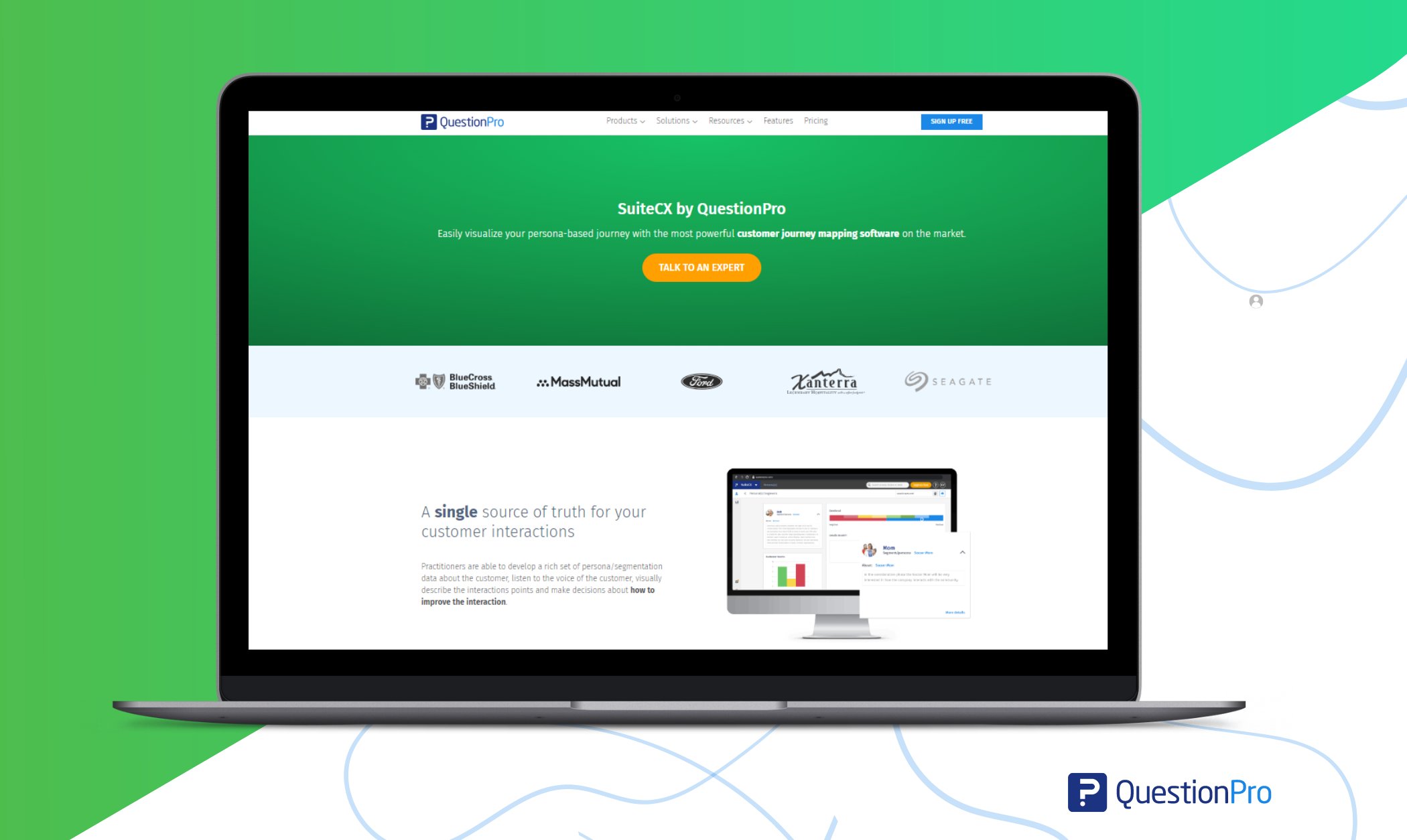
Features:
- Advanced survey creation and distribution capabilities.
- Real-time analytics for tracking customer feedback.
- Journey mapping tools to visualize the customer experience.
- Integration with CRM systems for seamless data management.
- Customizable reporting dashboards for actionable insights.
- AI-powered sentiment analysis to gauge customer satisfaction.
Limitation:
- Advanced features may require more effort and resources to be effectively used.
- May experience occasional bugs or glitches in the platform.
Pricing: Most popular plans start at $99 per month, with pricing tiers available for businesses of all sizes. Custom pricing options are available for enterprises with specific needs.
2. Insider
Insider is a platform that combines AI-driven predictive analytics, segmentation, and personalization to optimize customer journeys. It helps businesses deliver individualized experiences at every touchpoint to increase engagement and conversions.
Features:
- Predictive analytics to anticipate customer behavior.
- Personalization engine for tailored customer experiences.
- Multi-channel journey tracking across web, mobile, and offline channels.
- A/B testing for optimizing marketing campaigns.
- Customer segmentation is based on behavioral data.
- Automated workflows for personalized communication.
Limitation:
- Limited customization options for analytics reports.
- Challenges in integrating with specific third-party platforms.
- Higher pricing tiers may be prohibitive for smaller businesses.
Pricing: Offers custom pricing based on each organization’s specific needs and scale. Pricing is available upon request.
3. HubSpot Marketing Hub
HubSpot Marketing Hub offers a robust CRM platform with integrated marketing, sales, and service tools. It enables industries to track interactions, automate marketing campaigns, manage sales pipelines, and provide personalized support, all in one place.
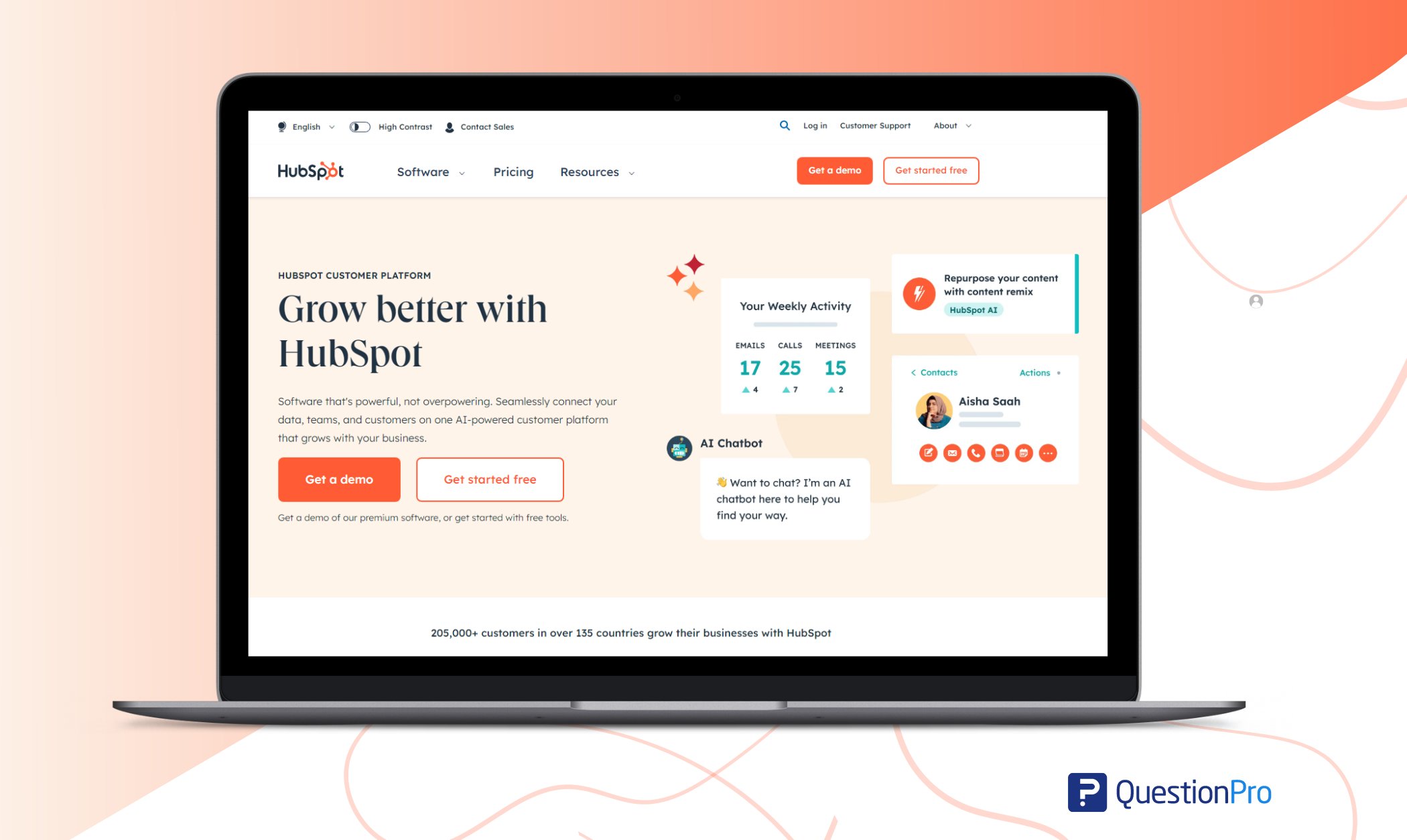
Features:
- Comprehensive CRM functionality for understanding customer interactions.
- Email marketing tools with automation capabilities.
- Landing page and website analytics for tracking visitor behavior.
- Lead scoring to prioritize high-value prospects.
- Social media monitoring for understanding customer sentiment.
- Integration with third-party apps for seamless data flow.
Limitation:
- Limited depth in analytics compared to dedicated analytics platforms.
- Challenges in tracking complex customer journeys across multiple channels.
- Certain advanced features may require additional paid subscriptions.
Pricing: The starter plan starts at around $50 monthly, with additional features available in higher-tier plans starting from $400 monthly.
4. Contentsquare
Contentsquare is a digital experience analytics platform that captures and analyzes customer interactions across web and mobile channels. It offers insights into customer behaviors, conversion pathways, and content effectiveness, enabling optimization of digital experiences.
Features:
- Heatmaps and session replays for visualizing user interactions.
- Behavior analysis to identify conversion barriers.
- Mobile app tracking to understand cross-device journeys.
- Journey attribution modeling for measuring campaign effectiveness.
- Customer journey segmentation based on user personas.
- Collaboration features for sharing insights across teams.
Limitation:
- May require significant training to utilize its capabilities thoroughly.
- Challenges in accurately attributing conversions across multiple channels.
- Integration limitations with some third-party tools.
Pricing: Offers custom pricing based on each organization’s specific needs and scale. Pricing is available upon request.
5. Mixpanel
Mixpanel is an advanced analytics platform focused on product and user behavior analytics. It helps businesses track user interactions, analyze engagement, and optimize product features to drive growth and retention.
Features:
- Event tracking to monitor user actions in real time.
- Funnel analysis to specify drop-off points in the conversion process.
- Cohort analysis for comparing user groups over time.
- Retention analytics to measure long-term customer engagement strategies.
- Experimentation tools for A/B testing and feature rollouts.
- Cross-platform tracking for unified customer insights.
Limitation:
- The higher learning curve for users new to analytics platforms.
- Limited support for specific data sources and integrations.
- Certain advanced features may require additional technical expertise to implement.
Pricing: The starter plan starts at around $24 monthly
6. Hotjar
Hotjar provides tools tailored for website and user feedback, including heatmaps, session recordings, and surveys. These tools offer valuable insights into user interactions with websites, enabling businesses to pinpoint areas for enhancement within the customer journey.
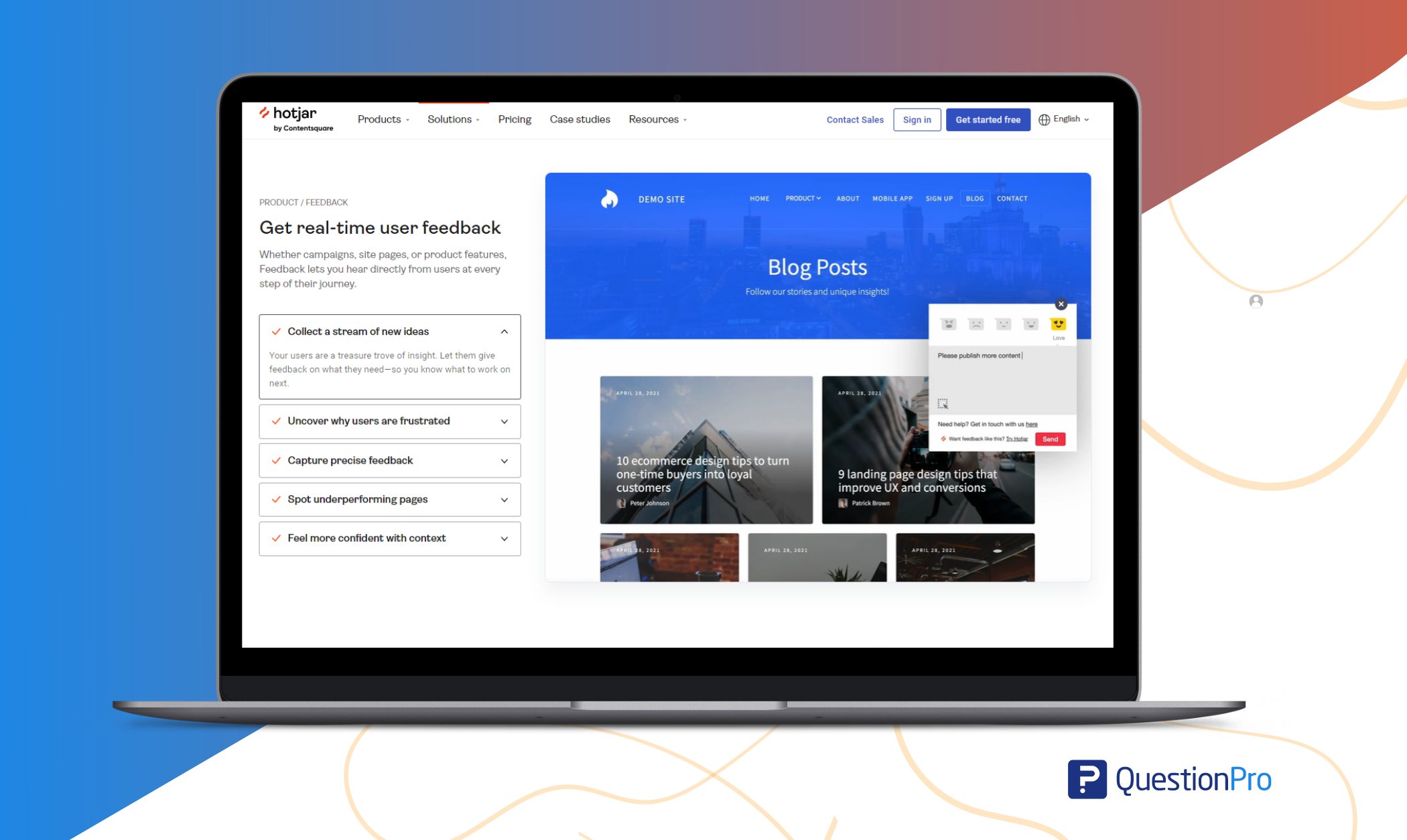
Features:
- Heatmaps and click tracking to understand customer behaviors.
- Feedback polls and surveys are used to gather user opinions.
- Conversion funnel analysis to identify areas for improvement.
- User session recordings for detailed insight into interactions.
- Behavior analytics to uncover trends and patterns.
- Integration with popular platforms for seamless data sharing.
Limitation:
- Limited flexibility in customizing feedback forms and surveys.
- Advanced analytics features may be overwhelming for users new to the platform.
- Some users may experience performance issues with large volumes of data.
Pricing: Pricing starts at around $39 per month for the Basic plan, with additional costs for higher-tier plans offering more features and higher traffic allowances.
7. Glassbox
Glassbox is a digital experience analytics platform that captures and replays website and app sessions to understand user behavior and identify issues. It provides insights into customer journeys, conversion funnels, and usability challenges.
Features:
- Session replay technology to visualize user interactions.
- Error detection and troubleshooting for improving user experience.
- Compliance monitoring to ensure data privacy and security.
- Machine learning algorithms for anomaly detection.
- Customer struggle analytics to identify friction points.
- Integration with digital experience platforms for seamless data exchange.
Limitation:
- Potential privacy concerns related to user data collection and recording.
- Limited support for specific compliance requirements, such as GDPR.
- Integration challenges with some third-party systems.
- Steeper learning curve due to complex features and functionalities.
Pricing: Offers custom pricing based on each organization’s specific needs and scale. Pricing is available upon request.
8. WebEngage
WebEngage is a customer engagement platform that combines marketing automation, personalization, and analytics to drive user engagement across channels. It helps businesses deliver relevant messages and experiences based on user behavior and preferences.
Features:
- Omni-channel journey orchestration for consistent customer experiences.
- Behavioral segmentation for targeting specific user groups.
- Campaign personalization is based on user actions and preferences.
- In-depth analytics dashboard for monitoring key metrics.
Limitation:
- Limited scalability for larger enterprises with complex data requirements.
- Challenges in accurately tracking cross-device customer journeys.
- Customization options for analytics reports may be restricted.
Pricing: Offers custom pricing based on each organization’s specific needs and scale. Pricing is available upon request.
9. Salesforce
Salesforce is a leading CRM platform that offers a wide range of customer journey analytics tools capabilities. It empowers businesses to monitor interactions, automate marketing initiatives, tailor communications, and deliver cohesive customer experiences across every interaction point.
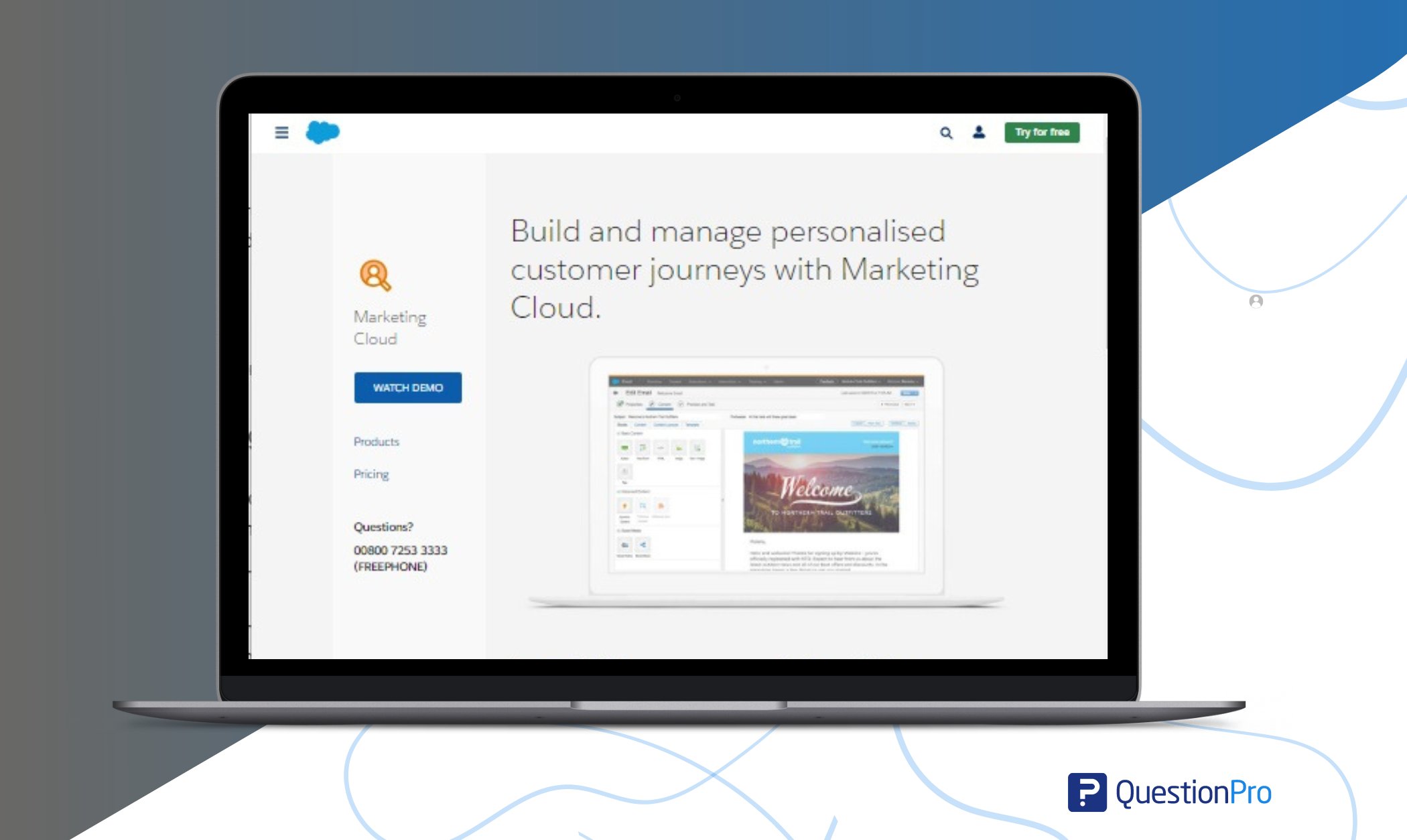
Features:
- Comprehensive CRM functionality for managing customer relationships.
- Customer journey mapping to visualize touchpoints and interactions.
- AI-powered analytics for predictive insights and recommendations.
- Integration with third-party apps and data sources for a unified view.
- Customizable dashboards and reports for monitoring key metrics.
Limitation:
- Higher pricing tiers may be prohibitive for smaller businesses.
- Limited out-of-the-box analytics capabilities compared to dedicated analytics platforms.
- Challenges in integrating with certain third-party systems.
- Customization options may require additional technical expertise.
Pricing: Offers custom pricing based on each organization’s specific needs and scale. Pricing is available upon request.
10. Woopra
Woopra is a customer journey analytics software that tracks and analyzes user interactions across multiple touchpoints. It provides real-time insights into customer behavior, segmentation, and engagement to optimize marketing and product strategies.
Features:
- Unified customer profiles for holistic insights into individual journeys.
- Real-time analytics for instant feedback on customer behaviors.
- Behavioral segmentation for targeted messaging and campaigns.
- Journey reports to visualize and analyze user paths.
- Integration with third-party tools and platforms for data enrichment.
- Predictive analytics for forecasting future user actions.
Limitation:
- Limited support for certain advanced analytics features.
- Integration challenges with some third-party systems.
- Reporting capabilities may lack depth compared to more comprehensive analytics solutions.
- Customization options for analytics reports may be restricted.
Pricing: Basic plans start at $999 per month.
11. SurveySparrow
SurveySparrow is a robust survey and feedback management platform designed to assist businesses in gathering, analyzing, and responding effectively to customer feedback. It offers advanced survey features, customization options, and analytics to understand customer sentiments and preferences.
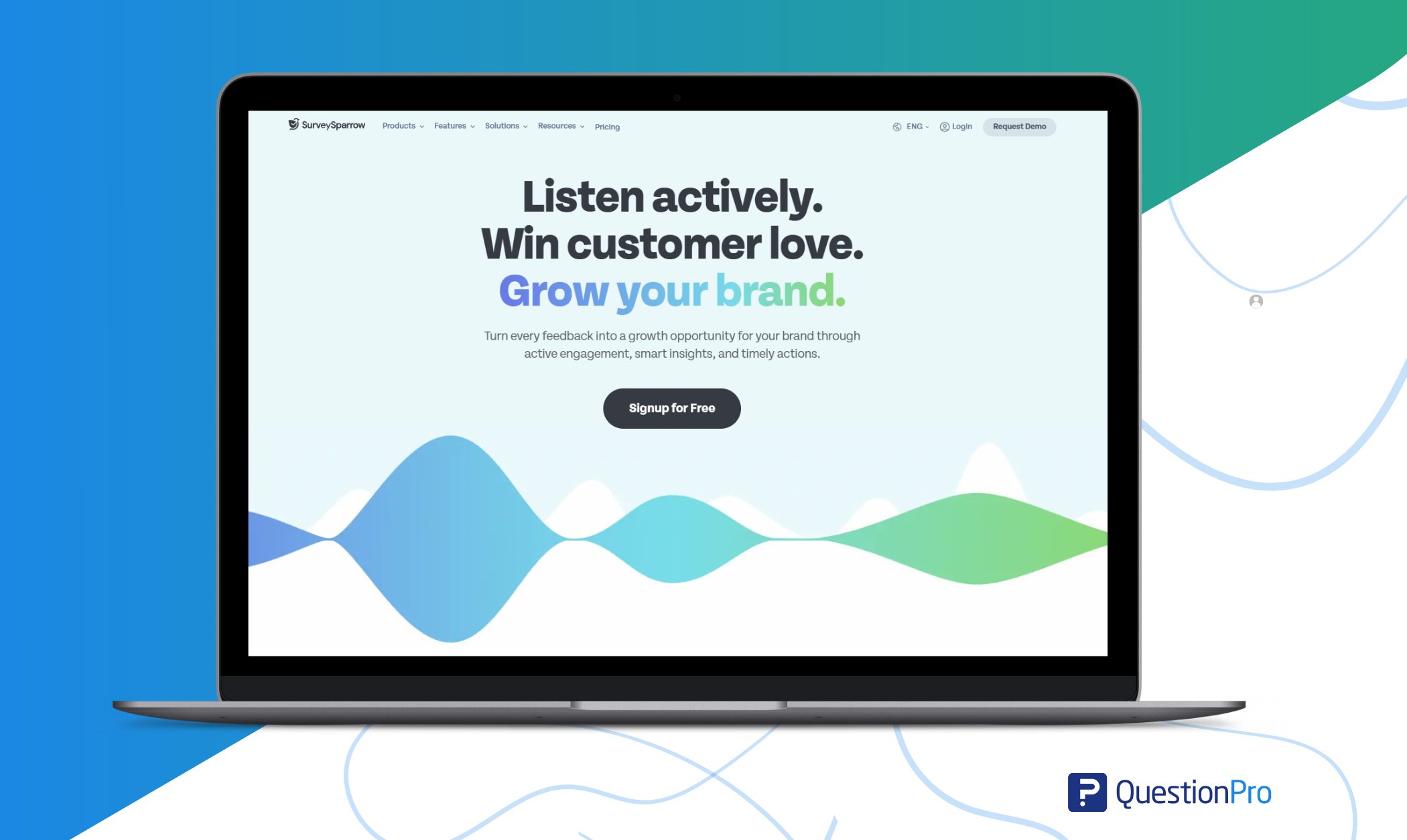
Features:
- User-friendly survey builder with customizable templates.
- Multi-channel survey distribution via web, email, and mobile.
- Advanced reporting features for analyzing survey responses.
- NPS (Net Promoter Score) tracking to gauge customer satisfaction.
- Automated follow-up surveys based on user responses.
- Integration with CRM systems for syncing survey data.
Limitation:
- Customization options for survey design may be somewhat constrained.
- Integration options with specific CRM platforms may be limited.
- Some users may find the interface less intuitive compared to other tools.
Pricing: Basic plans start at $39 per month and $59 for the starter. There are also other various plans for teams and enterprises.
These software solutions provide diverse features and functionalities to assist businesses in comprehending, assessing, and refining customer journeys. Their collective goal is to enhance customer engagement, satisfaction, and retention through data-driven insights and optimizations.
Check out our latest blog at QuestionPro SuiteCX to learn about Customer Loyalty Software. It could change how you keep your customers coming back!
Tips to Use Customer Journey Analytics Software
Leveraging customer journey analytics software effectively can transform how you understand and interact with your customers. To maximize the advantages of this powerful tool, consider the following tips:
1. Define Clear Objectives
Before diving into analytics, establish specific goals you aim to achieve. Whether it’s increasing customer retention, improving user experience, or boosting sales, having clear objectives will guide your analysis and help measure success effectively.
2. Integrate Data Sources
Combine data from various channels and systems, including your website, social media, and CRM tools. This integration offers a complete view of customer interactions and behaviors, providing more accurate and actionable insights.
3. Segment Your Audience
- Different customers have unique needs and preferences.
- Analyzing data across various customer segments helps identify these differences.
- Tailor your strategies to address the specific preferences and behaviors of each segment.
- This approach results in more effective marketing and engagement efforts.
4. Test and Iterate
Continuously test new approaches and use the data to refine your strategies. Iteration based on real insights helps you adapt and improve, ensuring your strategies remain effective and relevant.
5. Collaborate Across Teams
- Share insights with various departments, including marketing, sales, and customer support.
- Ensure collaboration across teams to align efforts and strategies.
- Enhance the overall customer experience automation through integrated teamwork.
6. Invest in Training
Proper training is important for maximizing customer journey analytics software use. Ensure your team is well-versed in both using the software and interpreting the data to leverage its capabilities thoroughly.
By following these tips, you can harness the full potential of customer journey analytics software to improve customer experiences, drive business growth, and achieve your strategic goals.
Why QuestionPro SuiteCX can be the Best Choice
QuestionPro SuiteCX is not just another customer journey analytics software. It’s a premier solution that stands out for its unique features and benefits:
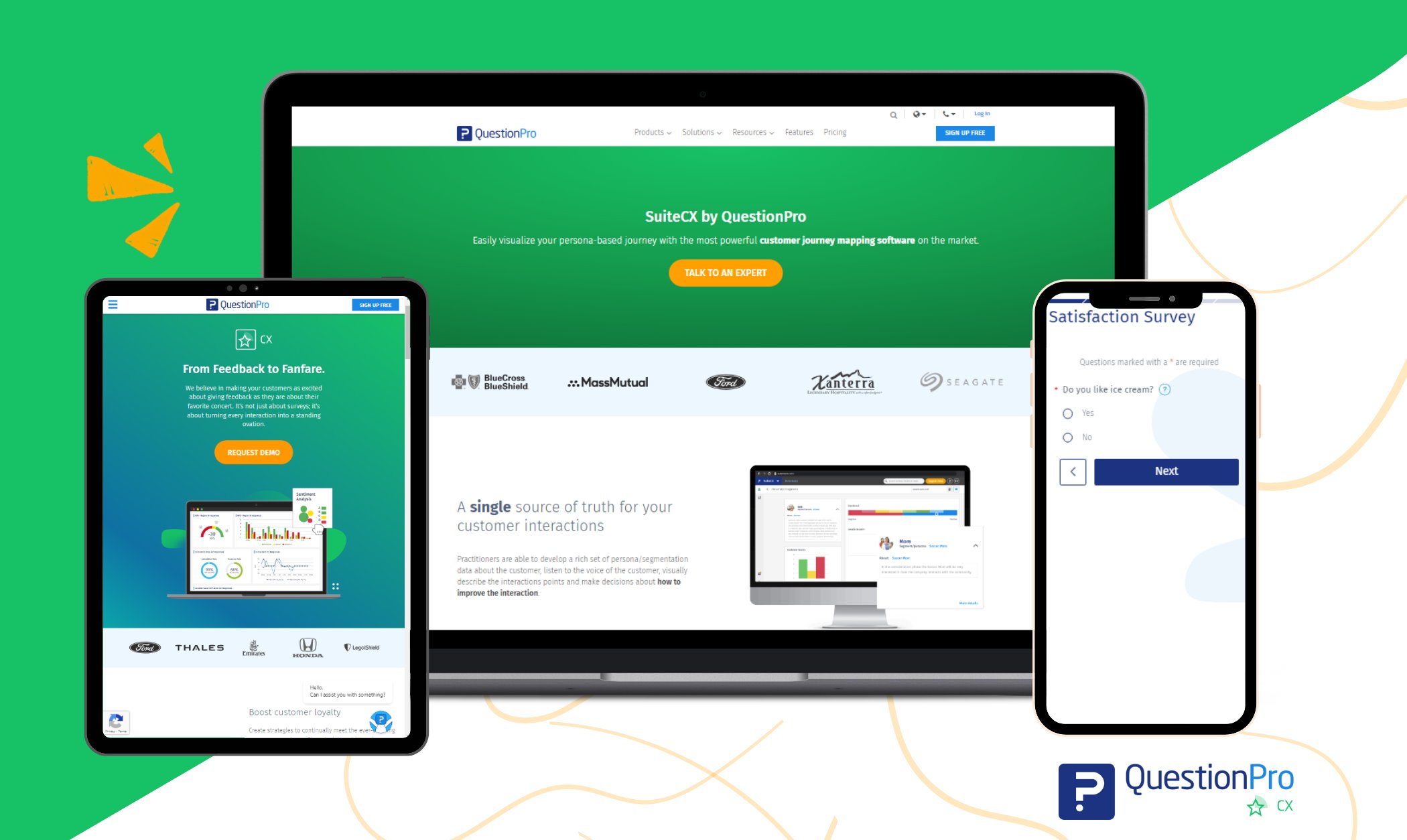
1. Robust Survey Capabilities
With its advanced survey creation and distribution features, QuestionPro SuiteCX enables businesses to gather comprehensive feedback at every customer journey touchpoint, facilitating a deeper understanding of customer preferences and pain points.
2. Real-time Analytics
- The platform provides real-time analytics, allowing businesses to monitor and analyze customer interactions as they happen.
- This feature empowers businesses to make timely decisions.
- Companies can adapt strategies quickly to meet evolving customer needs.
3. Journey Mapping Tools
QuestionPro SuiteCX offers sophisticated customer journey mapping tools that enable businesses to visualize the entire customer journey. These tools help identify key touchpoints, optimize pathways, and enhance the overall customer experience.
4. Integration with CRM Systems
Seamless integration with CRM systems ensures customer data is centralized and easily accessible. It enables businesses to leverage customer information to enrich their understanding of the customer journey data.
5. Customizable Reporting Dashboards
- The platform provides customizable reporting dashboards.
- Businesses can tailor insights to align with their specific needs and objectives.
- This flexibility enables stakeholders to focus on key metrics.
- Stakeholders can effectively derive actionable insights.
6. AI-powered Sentiment Analysis
QuestionPro CX leverages AI-powered sentiment analysis to gauge customer satisfaction and sentiment across various touchpoints. It enables businesses to proactively address issues and capitalize on opportunities to enhance customer experiences.
QuestionPro SuiteCX’s comprehensive feature set, real-time analytics capabilities, and focus on enhancing customer experiences make it a top contender for businesses seeking to optimize their customer journey analytics efforts.
Curious about how to gain deeper customer insights? QuestionPro SuiteCX’s latest blog delves into its Customer Insight Platform, offering valuable tips and strategies!
Conclusion
Customer journey analytics software provides businesses with the tools to navigate this complex landscape effectively. By harnessing the power of data, these solutions offer invaluable insights into every facet of the customer journey, spanning from the initial interaction through the conversion phase and beyond.
Organizations can cultivate more meaningful and personalized customer interactions by leveraging customer journey analytics software. By pinpointing pain points and areas ripe for improvement, businesses can fine-tune their products, services, and marketing endeavors to align closely with the desires and expectations of their target audience.
In essence, customer journey analytics software enables industries to harness the full potential of customer data, facilitate more strategic decision-making, and ultimately deliver standout experiences that distinguish them in today’s competitive marketplace.
Customer journey analytics is the process of tracking and analyzing how customers interact with a business across multiple touchpoints and channels over time.
Adobe Analytics is a web analytics tool that collects and analyzes data from websites and other digital channels to understand user behavior and optimize online experiences.
On the other hand, customer journey analytics encompasses a broader approach that tracks and analyzes customer interactions across multiple touchpoints and channels over time, providing a comprehensive view of the entire customer experience from initial contact to post-purchase.
No, customer journey analytics does not replace Adobe Analytics. Instead, it complements tools like Adobe Analytics by providing a more comprehensive view of customer interactions across all touchpoints and channels, beyond just web and digital analytics.







